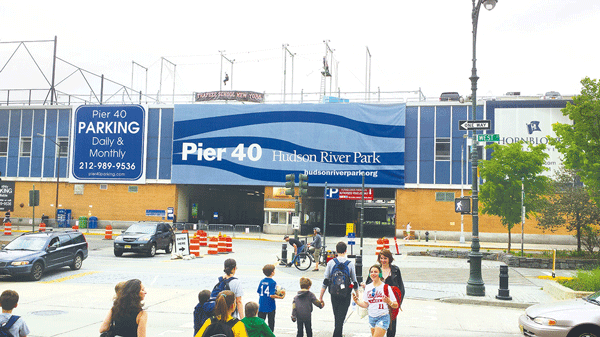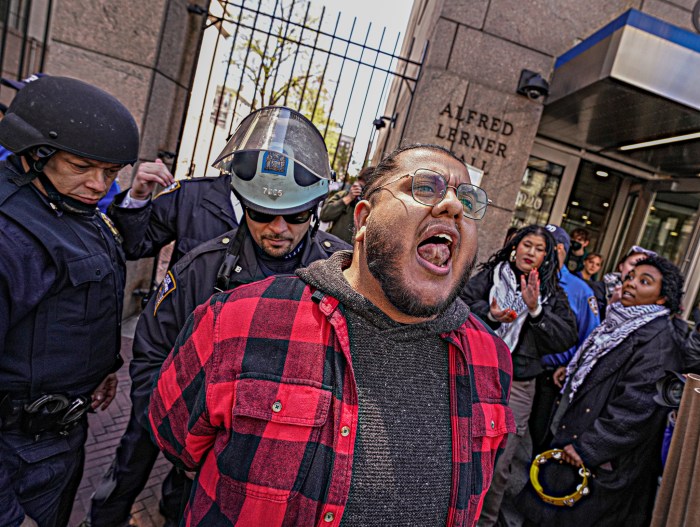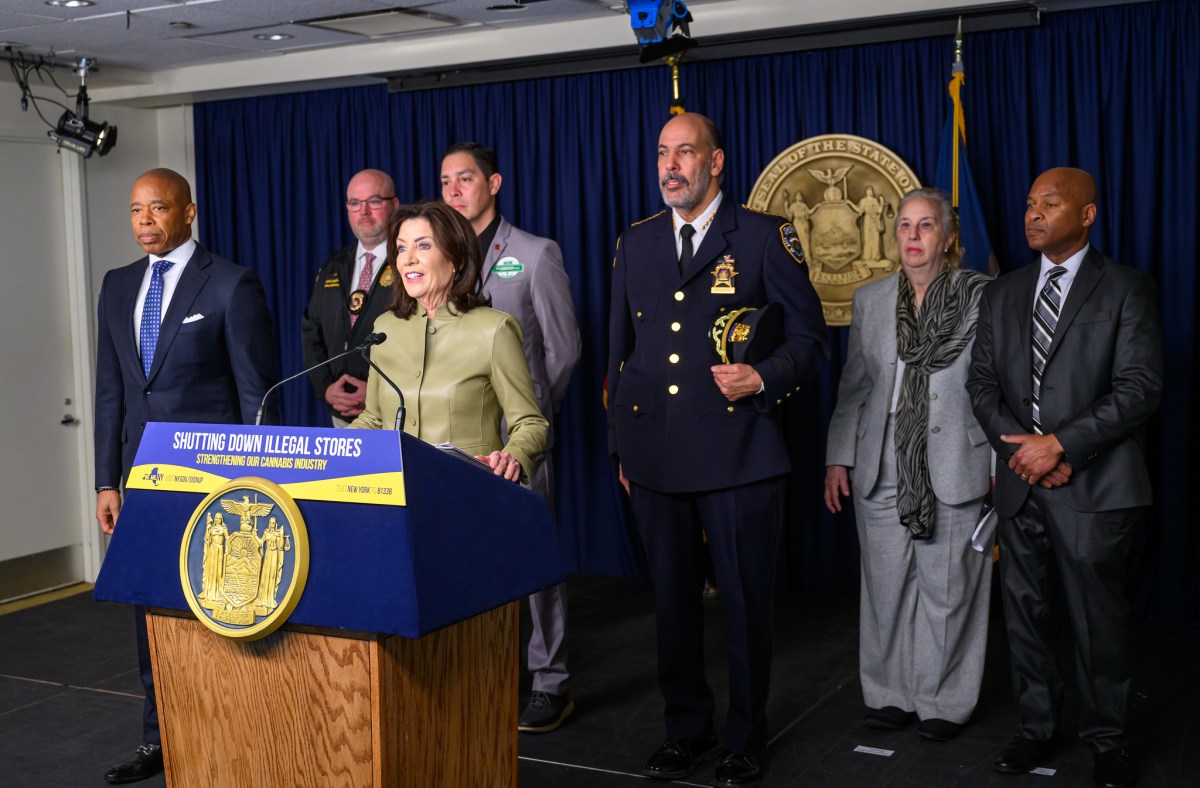
BY LINCOLN ANDERSON | The sports pier is a political football — again.
It came as a shock last Friday when local elected officials and community board members were told by a state official that a secret agreement was signed six months ago between Governor Cuomo, the Hudson River Park Trust and an owner of the St. John’s Center — the Atlas Capital Group — to transfer $100 million worth of air rights from Pier 40 across the highway to the St. John’s Center building site at West and Houston Sts.
Under this plan, the four-story-tall, three-block-long St. John’s Center in Hudson Square would reportedly be demolished in phases over 10 years and the site rebuilt with several residential buildings and retail shops. Per the waterfront park’s recently approved air rights legislation, the $100 million would have to be funneled back into the 14-acre Pier 40 for its repair and maintenance.
What’s more, a New York Times article about the Pier 40 / St. John’s Center plan that came out the day before last Friday’s stunning announcement, reported that, “Officials say that this proposal would have to go through a state review process, but not necessarily a city-led review.” In other words, no Uniform Land Use Review Procedure (ULURP) would be required. The state review process is known as a General Project Plan, or G.P.P.
In a follow-up article, the Times subsequently reported that, this Tuesday, Alicia Glen, Bill de Blasio’s deputy mayor for economic development, told the Trust’s board of directors that the proposal “would need to be examined by the local community board, the city’s planning department and the City Council.”
Yet, as this second Times article noted, the city’s position on Pier 40 “puts the Mayor’s Office at odds” with the plan developed by Governor Cuomo’s administration, “which had sought a speedy state review that would bypass input from the local community.”
In other words, despite de Blasio’s desiring a ULURP, it’s not clear that Cuomo will agree to it — and the state trumps the city on land-use matters.
Asked if the governor would now agree to a ULURP for any Pier 40 / St. John’s Center air-rights transfer plan, a spokesperson for the Empire State Development Corporation — the state’s development agency — issued the following statement, which did not exactly sound like a guarantee.
“We will continue to work with the city administration, local elected officials and community stakeholders on the most appropriate and quickest way to address the pier’s rapidly increasing deterioration,” the spokesperson said. “That said, we believe the state’s proposal provides for a more timely and effective approach to meeting the imminent capital needs of the pier. The sooner the pier is repaired, the less likely the community will lose its use of the pier.”
State Senator Brad Hoylman hailed the city’s call for a ULURP review of a St. John’s Center plan as “a big victory for the local neighborhoods that might be affected by the development.”
In a statement, Hoylman said, “A G.P.P. would be an end run around the local zoning process and deny the public the opportunity to weigh in sufficiently.
“This project has the potential to provide an important infusion of funds for the Hudson River Park and Pier 40, but also will have consequences for the neighborhoods on the Far West Side that need to be studied closely. It’s crucial that the opinions of the people most directly affected by it be taken seriously into account.”
On Monday, Congressmember Jerrold Nadler told The Villager he expected to get a look later that day at the M.O.U. between the state and Atlas, and would report back to the newspaper on its contents. But Nadler never did see the M.O.U.
The Times described the memorandum as “secret and tentative.” The agreement, the paper said, “would require approval by City Hall, but would be subject to state review, which is not as rigorous and does not require community input.”
“Apparently it has existed for quite a while — I think since December — and it calls for a General Project Plan,” Nadler said of the M.O.U. “Everyone [at the meeting] was upset that it might not go through ULURP. We said it should be revoked.”
The St. John’s Center is owned by Atlas Capital Group, Fortress Investment Group and Westbrook Partners.
After Deputy Mayor Glen’s statement calling for ULURP, however, Hoylman indicated that the agreement for the air rights transfer to Atlas — which stipulates only a state review process — is no longer valid.
“Nobody to my knowledge has seen the M.O.U., which would appear now to be moot,” he said.
However, Andrew Berman, executive director of the Greenwich Village Society for Historic Preservation — who has been a vocal watchdog on the park air rights issue — was far from reassured.
“The mayor does not appear to have any ability to force the deal to go through the city’s land-use review process or to make the city approvals conditional for the deal moving ahead — as opposed to simply allowing the city to review the plan and issue nonbinding recommendations — though it is possible that the mayor could persuade the governor to allow this,” Berman said. “The city’s ULURP process far from guarantees a good outcome. But it does at least have the benefit of requiring approval of the City Council, over which the local councilmember can exert influence, thus giving the local community some opportunity to potentially affect the outcome.”
Last Friday, Berman wrote Madelyn Wils, the Trust’s president, saying that word of the tentative agreement and the fact that the project would be approved via G.P.P. is “especially troubling because in recent public forums you have repeatedly stated that no deal or arrangement to allow the transfer of air rights was imminent, and that a long, public ULURP process, which would give local elected officials a say in determining the outcome, would be required before any action was taken.”
The transfer of air rights from Hudson River Park up to one block inland from the park was made possible last year by state legislation hurriedly introduced — without any prior opportunity for public review — at the very end of the legislative session. The bill was introduced in the Assembly by Assemblymembers Deborah Glick and Richard Gottfried and had no sponsors in the state Senate.
Asked this week whether any potential air rights transfer from Pier 40 to the St. John’s Center site should go through ULURP, Wils said that’s for the state and city to decide.
“The Hudson River Park Trust’s interest is in preserving Pier 40 and finishing the park,” she said in a statement to The Villager on Wednesday. “Decisions beyond park boundaries are up to the city and state. H.R.P.T. looks forward to a public process that ensures everyone’s voice is heard while we work together to save Pier 40.”
What is clear is that Pier 40 is sorely in need of a major infusion of funds to keep it afloat. The Trust president has repeatedly stressed that the pier’s situation is dire and that immediate infrastructure repairs are needed.
At the Trust’s board of directors meeting on Tuesday, no mention was made of the Pier 40 air rights agreement with Atlas. A Trust official later explained this was “because no action was taken” on this issue. However, the directors did vote to approve a contract to retain the Bryan Cave lawfirm for “legal services” relating to the park’s air rights transfers.
In addition, Wils, during her report to the board members, cited the findings of a recent engineering group’s report that inspected Pier 40’s support piles and found that more than 57 percent of them are severely damaged.
“At some parts of the pier, the load is at the brink of capacity to allow public use,” she said.
In addition, Hoylman last week questioned whether the secret M.O.U. with Atlas violated the Hudson River Park Act — the park’s founding legislation — which states that a public hearing is needed for any action that significantly affects the park.
The Park Act, Hoylman noted, “was founded on the principles of public engagement and transparency. In this spirit, if any deal is going to move forward to transfer the reported $100 million of air rights to the St. John’s Building, it needs to be done in a manner that includes robust community engagement.”
The Park Act states, “in the case of any proposed significant action affecting the park or community,” it’s required that there be public hearings and solicitation of the views of the local community boards, the city, the Hudson River Park Advisory Council and public officials.
“This clearly didn’t happen, even though a $100 million M.O.U. seems to be a ‘proposed significant action,’ ” Hoylman told The Villager.
“I’m deeply troubled that a memorandum of understanding worth $100 million signed by the Hudson River Park Trust, E.S.D.C. and a private developer wasn’t shared in advance with elected officials or community boards who represent the affected community.”
However, a Trust source countered that it’s not necessary to hold a public hearing, again, because “there is no significant action. There’s no deal.”
The Park Act specifically says that if a G.P.P. is “adopted,” then a public hearing must be held and a community process initiated.
Borough President Gale Brewer has reportedly made a formal request to see the M.O.U.
Following last Thursday’s Times article announcing the possible deal for Pier 40’s air rights, local elected officials fired off a joint statement opposing a G.P.P., headlined, “Setting the record straight on Pier 40 and Hudson River Park.” Signing on to the statement were Nadler, Glick, Hoylman, state Senator Daniel Squadron, Brewer and Councilmember Corey Johnson.
“A G.P.P. would completely usurp local zoning and local input from the community and is in no way condoned by the Hudson River Park Act,” they said. “It is the same land-use procedure that brought the Barclays Center to the Atlantic Yards, despite widespread disapproval from that community.”
In fact, just a few weeks earlier, the local politicians — having heard renewed rumblings of a possible G.P.P. at the St. John’s Center — had sent a joint letter to Cuomo and de Blasio saying they opposed any such plan. That, in turn, led to the scheduling of last Friday’s meeting, at which the E.S.D.C. representative let slip that a G.P.P. for Pier 40’s air rights had, indeed, already been signed. The politicians at the meeting were stunned that — rather than receiving a letter in response from the Cuomo administration to their May 1 letter — they instead had to read the governor’s position in The New York Times article about Atlas’s St. John’s Center plan.
Local officials had first heard of the possibility of a G.P.P. at the St. John’s Center site last fall.
“A G.P.P. would…rightfully enrage the community, which would be effectively left powerless through this process,” the local pols had written on May 1 to de Blasio and Cuomo. “Any lip service paid to the needs of the community would only be that, as the local officials who have a formal role in the ULURP process, the city councilmember and borough president, will have no binding authority when it comes to negotiating any agreement, or voting on whether to approve the proposal. … If a G.P.P. moves forward,” the declared, “we will actively oppose it.”
As well as the development profits set to be made at the St. John’s Center site by an air transfer deal, also driving the push for action is the Lower West Side’s booming youth sports culture. For a huge constituency of local families, Pier 40 is their go-to spot for after-school and weekend youth sports activities.
Tobi Berman, a leader of Pier 40 Champions — a coalition of youth sports leagues that is pushing for repairs of Pier 40 A.S.A.P. — stressed that further delays could be disastrous.
“The problem we are facing is that the design work for the reconstruction of the support structure of the pier needs to begin this year, or the unacceptable prospect of the pier closing in a couple of years becomes real,” Bergman told The Villager. “The loss of the fields will be devastating for our Downtown communities, and the loss of income from the pier will be devastating to the whole Hudson River Park. An open process for getting this done is important, but the responsibility for getting it done and saving this important resource rests with all the people we elect to positions of influence and power. Delay is apparently no longer an option.”
Bergman added that more questions also need to be asked, such as, “On what timetable will the funds for Pier 40 be available? What will the new uses be at St. John’s Center, and how big will the buildings be? Will there be other community benefits, like affordable housing and schools? And how will the impacts be assessed and what will the public process be going forward?”
Arthur Schwartz, first vice chairperson of the park’s advisory council, said Cuomo’s deal with Atlas is “basically using the park as cover to promote the goals of the developer, who will probably make billions off that project in return for the $100 million for Pier 40.
“It was done totally top-down,” Schwartz said. “Just top-down government is intolerable. And there will be such a brouhaha about this that it won’t get done — and Pier 40 will continue to crumble.”
Attorney Norman Siegel was retained by Jean-Louis Bourgeois to fight the air rights transfer plan.
“Our position continues to be that ULURP process should apply at least to the city-owned property [in the park],” Siegel said. “And if, in fact, there’s not going to be any ULURP process, we’ll have to give serious consideration to challenging that.”
Half of the 5-mile-long park was city-owned and half was state-owned before the park’s creation in 1998. But Assemblymember Gottfried has said he thinks those distinctions may have been swept away when the Trust, a state-city authority, was created to administer the park.

















